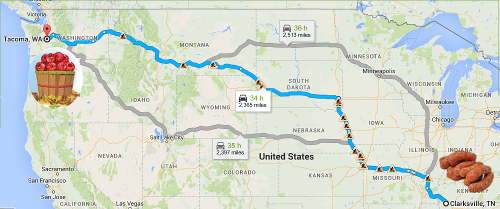
After reading Create a Simple Business Model (part 1) you’re probably ready to start creating your own business model. Before you start, there is more to learn about a trucking business model.
Surprising to most new truck owners establishing your base rate is not what you will want to include on a contract for a potential new customer. But rather it is a bottom line rate where you are able to maintain an acceptable profit margin. Just as surprising to new truck owners is that your base rate will be different for different lanes, different directions and different seasons.
My best example I like to use comes from my many years of experience hauling perishable meat and produce. During the winter months there is more produce in Arizona than trucks to haul it. Therefor your base rate will be higher during the winter months to haul produce for 2 reasons.
1. Most likely your customers shipping to Arizona know when produce season is because other carriers are calling them attempting to garner their business by offering lower rates.
2. During the summer months your rates to Arizona will also adjust higher compensating for the lower produce or general freight rates.
Produce haulers ideally will attempt to negotiate an all
seasons year around rate somewhere between summer and winter rates.
That gives them a consistent reliable cash flow they can manage their
expenses with. It also gives their customer the added benefit of
knowing their transportation costs. This gives the producer customer
the ability to more accurately and constantly provide quotes to their
customers. Knowing this and using it to your advantage will help you
negotiate a quality long term contract both you and the customer
appreciate.
To determine your base rate use the chart in chapter 1 to establish your expected expenses. Then divide the total cost of your expenses by the estimated total miles you anticipate operating. That is your base cost. However some customers may through you a curve and you’ll need an answer on the spot. Sometimes customers will say “our rates include the fuel surcharge.” In that instance you will need to know what your base rate is with the current fuel surcharge. I use this formula to establish my base rates.
Base rate without fuel surcharge:
Expenses = E
Estimated Miles = M
Base Rate = B
E ÷ M = B
Base rate with fuel surcharge:
Expenses = E
Estimated miles = M
Base Rate = B
Fuel Surcharge = F
(E ÷ M) + F = B
Using the method described in Carrier Rate Agreement or Carrier Contract calculate your detention pay. We all know that while we are loading and loading most of us do not receive anything additional. Customers will say something like “that’s in the rate” or an all time favorite of mine, “that’s part of your job.” I personally prefer to have an appointment time for pickups and deliveries because that gives me the strongest position to negotiate from. I will tell the customer “I only have a 1 hour window before it costs me money.” Now the negotiations have begun. Typically if the customer is comfortable with 1 hour before detention pay begins they will accept. Many times they will respond with a 2 hour offer before detention pay begins. If the customer is being unwilling I will tell them there is a rate without detention pay however it is much higher. If it is first come first serve it can work for you or against you. Either way, if possible detention pay should still be included in your contract. If the customer is unwilling to take responsibility for any detention pay you may want to re-evaluate if they are a customer you wish to do business with. For example I have been known to charge a rate 3 times higher than my normal rate quote if I am asked to take a load to Kroger in Shelbyville IN. That distribution center is known to not unload produce trucks for 6 hours or more (it happened to me) and in some cases more than 24 hours beyond their scheduled delivery. So taking the time to ensure you are comfortable without detention pay, especially with all the added pressure for compliance from law enforcement and the FMCSA, may well be worth your time.
Labor rates include everything from tarping, hand truck, tailgating, breakdown, pallet jack work, driving a fork lift and much more depending on the industry. Normally your customer will be familiar with labor rates especially if they have cargo requiring labor. Just like with detention pay you will need to negotiate for it and the customer will say the same things as they did for detention pay “it’s included in the rate” or “that’s your job.” Same negotiation skills are required as before. It must be noted that the majority of freight does not require an added labor. In fact I have frequently agreed to a contract with a customer with no labor rates even though I had to do some labor. Why you ask? Because I expected the customer would not want or agree to labor rates so I had it already figured in my base rate before I negotiated the contract. That is part of doing your market and customer research in advance of any negotiations.
Fuel surcharges have been a mainstay in the trucking since the late 1970’s. That was when oil and fuel first had it’s dramatic cost spike. Since then customers have grown to expect and accept fuel surcharges. Occasionally you will still find a rare customer or two that insists that this to is included in the base rate. However they are becoming few and far between. When negotiating a fuel surcharge with a customer who has never agreed to one you should first point out to them what they stand to gain from a fuel surcharge. A fair consistent rate that when fuel costs goes up yes they will increase their shipping costs. But likewise when fuel costs go down it decreases their shipping costs. Not to mention the added value in keeping you operating in the black and providing them with a guaranteed truck to get their product to market instead of relying on brokers or spending time on the phone trying to find a truck themselves. Both can be very powerful positions to negotiate from. Determining the fuel surcharge rate is easier than the negotiations. The industry standard for many years has been that truck owners accept the fuel cost in the base rate up to $1.00 per gallon and the trucks average 5 mpg. Thus each time fuel cost rise $.05 per gallon it costs the truck owner an additional $.01 per mile in fuel. Therefor for every $.05 the national average of fuel increases over $1.00 per gallon your fuel surcharge is an additional $.01 per mile.
When estimating your profit margin be reasonable and realistic. Any loan officer will be able to read through embellishments or exaggerations you may be tempted to use. Your goal when estimating your profit margin is to show any bank, credit union or investor that you have a solid understanding on how to earn a reasonable profit owning a truck and running it as a successful business.
Now it’s time to organize and create your simple or rough draft business plan. I have always been most successful using the philosophy that less is more when creating a business plan. In the simple business plan you are organizing all your customer base, costs, gross income and profit. Since this a rough draft it is the foundation for creating your formal business plan. Learn how to write and Make a Business Plan for trucking in my post Make a Business Plan.
